| Coat of arms of Bashkortostan | |
|---|---|
 | |
| Armiger | Republic of Bashkortostan |
| Adopted | 25 February 1992 |
| Use | On treaties, commissions, and more |
The coat of arms of Bashkortostan is a national symbol of the Republic of Bashkortostan, Russia.
| Coat of arms of Bashkortostan | |
|---|---|
 | |
| Armiger | Republic of Bashkortostan |
| Adopted | 25 February 1992 |
| Use | On treaties, commissions, and more |
The coat of arms of Bashkortostan is a national symbol of the Republic of Bashkortostan, Russia.
It features the monument to Salavat Yulaev in Ufa against the rising of the sun and its rays, inscribed in the circle framed with the national ornament. Below shows the inflorescence of the Bashkor rose ( Pleurospermum uralense ), painted in the colors of the national flag of Bashkortostan, with an inscription of the name "Bashkortostan" (Bashkir : Башҡортостан) on white. [1]

The penultimate USSR-era flag was adopted by the Russian Soviet Federative Socialist Republic (RSFSR) in 1954 and used until 1991. The flag of the Russian SFSR was a defacement of the flag of the USSR. The constitution stipulated:
The state flag of the Russian Soviet Federative Socialist Republic (SFSR) presents itself as a red, rectangular sheet with a light-blue stripe at the pole extending all the width [read height] which constitutes one eighth length of the flag.
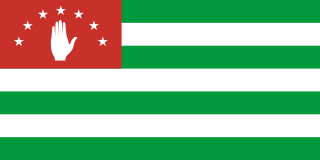
The flag of the Republic of Abkhazia was created in 1991 by Valeri Gamgia. It was officially adopted on 23 July 1992.

The flag of Udmurtia is one of the official state symbols of the Udmurt Republic, along with its emblem and anthem. The proportion of width and length of the flag is 1:2. It is a rectangular three-color cloth consisting of vertical equal stripes of black, white and red with an eight-pointed red cross. The black colour in the flag is a symbol of the earth and stability, red means the sun and life and white means a space and moral purity. The designer of the flag of the Udmurt Republic was Yuri Lobanov. The appropriate law N26-РЗ "On the National Flag of the Udmurt Republic" appeared on 30 April 2002.

The flag of the Chuvash Republic, a republic of the Russian Federation, is one of the official symbols of the Chuvash Republic, alongside the coat of arms and the state anthem. The flag is a 5:8 yellow flag with a stylized red tree of life charged on the flag. The flag has been used officially as the flag of the Chuvash Republic since 14 October 1992.

The state flag of the Sakha Republic (Yakutia) in Russia is one of the official symbols of the Sakha Republic, alongside the coat of arms and the national anthem of the Sakha Republic. The flag has four horizontal stripes. From top to bottom, the stripes are light blue, white (1/16), red (1/16), and green (1/8). The flag has been used officially as the flag of the Sakha Republic since 14 October 1992. The light blue stripe is charged with a white disc in the center. The diameter of the disc is 2/5 of the flag's width.

The coat of arms of the Kazakh Soviet Socialist Republic was adopted on 26 March 1937 by the government of the Kazakh Soviet Socialist Republic. The coat of arms is based on the coat of arms of the Soviet Union.
The emblem of the Moldavian Autonomous Soviet Socialist Republic was an official emblem used in the Soviet Union in the early 20th century. It had underwent a number of changes over time.

The flag of the Republic of Bashkortostan is one of the official state symbols of Bashkortostan, a federal subject of Russia, alongside the coat of arms and anthem. The flag has three horizontal stripes. From top to bottom, the stripes are teal blue, white, and green. The flag has been used officially as the flag of the Republic of Bashkortostan since 25 February 1992. The white stripe of the flag is charged with a kurai flower in the center.

The flag of Mari El, a federal subject and republic in the Russian Federation, was adopted by the Parliament of Mari El on 1 June 2011.
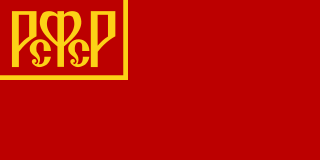
The Russian Soviet Federative Socialist Republic, previously known as the Russian Soviet Republic and the Russian Socialist Federative Soviet Republic, and unofficially as Soviet Russia, was an independent federal socialist state from 1917 to 1922, and afterwards the largest and most populous constituent republic of the Soviet Union (USSR) from 1922 to 1991, until becoming a sovereign part of the Soviet Union with priority of Russian laws over Union-level legislation in 1990 and 1991, the last two years of the existence of the USSR. The Russian SFSR was composed of sixteen smaller constituent units of autonomous republics, five autonomous oblasts, ten autonomous okrugs, six krais and forty oblasts. Russians formed the largest ethnic group. The capital of the Russian SFSR and the USSR as a whole was Moscow and the other major urban centers included Leningrad, Stalingrad, Novosibirsk, Sverdlovsk, Gorky and Kuybyshev. It was the first socialist state in history.

The Government of Bashkortostan is a governing body of Bashkortostan in Russia which exercises executive power under the authority of the Republic Head whom appoints cabinet which is composed of the Prime Minister, the deputy prime ministers, and the ministers that are approved by the governing legislature is the State Assembly.
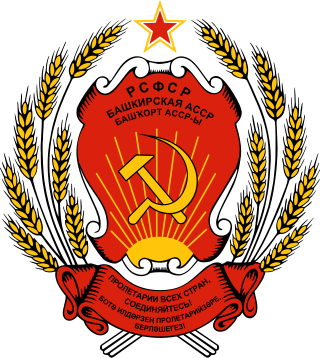
The emblem of the Bashkir Autonomous Soviet Socialist Republic was adopted in 1937 by the government of the Bashkir Autonomous Soviet Socialist Republic. Its design is based on the emblem of the Soviet Union.
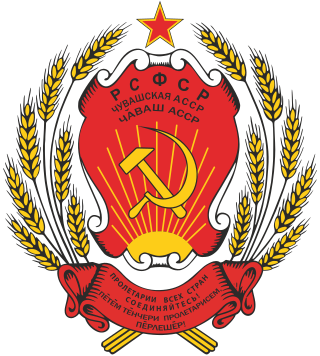
The national emblem of the Chuvash Autonomous Soviet Socialist Republic was adopted in 1937 by the government of the Chuvash Autonomous Soviet Socialist Republic. The emblem is identical to the emblem of the Russian Soviet Federative Socialist Republic.
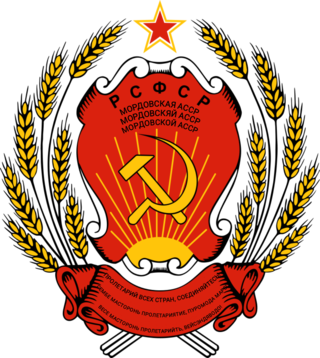
The national emblem of the Mordovian Autonomous Soviet Socialist Republic was adopted in 1937 by the government of the Mordovian Autonomous Soviet Socialist Republic. The emblem is identical to the emblem of the Russian Soviet Federative Socialist Republic.
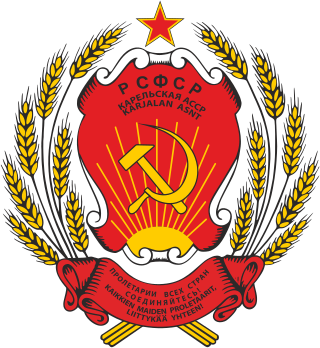
The national emblem of the Karelian Autonomous Soviet Socialist Republic was adopted in 1937 by the government of the Karelian Autonomous Soviet Socialist Republic. The emblem is identical to the emblem of the Russian Soviet Federative Socialist Republic.
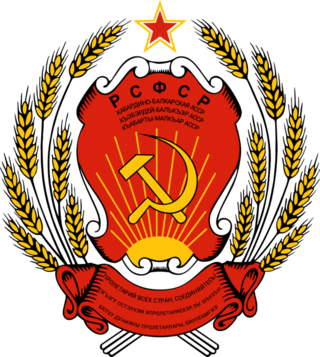
The national emblem of the Kabardino-Balkarian Autonomous Soviet Socialist Republic was adopted in 1937 by the government of the Kabardino-Balkarian Autonomous Soviet Socialist Republic. The emblem is identical to the emblem of the Russian Soviet Federative Socialist Republic.
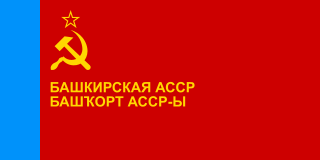
The flag of the Bashkir Autonomous Soviet Socialist Republic was adopted in 1954 by the government of the Bashkir Autonomous Soviet Socialist Republic. The flag is identical to the flag of the Russian Soviet Federative Socialist Republic.

The coat of arms of the Sakha Republic, in the Russian Federation, is an official symbol of the Sakha Republic, alongside the flag and the national anthem of the Sakha Republic. The coat of arms consists of a circle, in the center of which is a red silhouette of a rider on horseback holding a banner, based on the prehistoric petroglyphs of the "Shishkin pisanitsa", against a white sun background. The central image is framed with a traditional Sakha ornament in the form of seven rhombic crystal-like figures and the inscriptions "Республика Саха (Якутия) • Саха Өрөспүүбүлүкэтэ". This coat of arms has been used officially since 26 December 1992.
The emblems of the autonomous republics of the Union of Soviet Socialist Republics are the heraldic symbols of the respective Autonomous Soviet Republic.